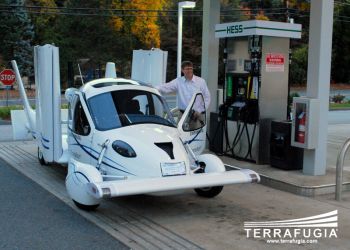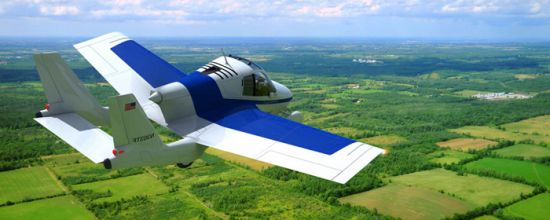Though many have tried and failed, those attempting to combine ground and sky with street-legal aircraft are presented with a new window of opportunity through which they can feasibly offer their innovations to the masses. Joint exploratory research conducted by NASA and the FAA has created the groundwork for an overhaul of our nation’s airspace and aviation system, allowing for an unprecedented increase in airspace traffic. This development, along with a breakthrough effort to include the untapped resource of over 5,000 public airports around the country, could lead to a revolution in how we approach civil transportation.
History of Aviation
Ever since the Wright brothers first took flight in the early 20th century, the aspiration to control the skies has become a prominent goal throughout modern society. From commercialized air travel to space exploration, the science of aeronautics has grown and evolved over the last century into a multifaceted world of benefits to people all over the globe. The field of aeronautics has experienced many ground-breaking and exciting innovations, but the ‘holy grail’ of human flight is the concept of flying cars. The thought of personalized flying machines that surpass street cars in efficiency and allow passengers to cover large distances in short times is a thrilling one. When faced with the idea of flying cars, it might be easy to think of the fictional, futuristic utopias found in popular fiction like The Jetsons or Star Wars. However, due to many problems like dated highway infrastructure, steadily increasing motor vehicle traffic, and the growing issue of inefficient commercialized flights, some engineers have already begun looking to the sky for solutions. Leading aviation inventors, the Federal Aviation Administration (FAA) and the National Aeronautics and Space Administration (NASA) are hoping to change the world of civil transportation.
Civil Transportation Issues
Growing issues, one of which is the increasing number of vehicles on the road, plague the transportation systems of much of the industrialized world. To make matters worse, motor vehicle production has steadily increased since 2000. Though global production of motor vehicles has averaged around 45 million per year in the last decade, in 2007, car production rose from 49.1 million to 52.1 million. These figures put the approximate number of motor vehicles around the world at over 620 million [1]. In the United States alone, the number of passenger vehicles has increased from 225 million in 2000 to about 255 million in 2008 [2].
With over 30 million new passenger vehicles on the road in the last ten years and a relatively stable roadway infrastructure, congestion is a growing problem, particularly in the United States. According to a poll administered by TNS Global, the average American spends about 87 minutes in the car every day. A corresponding figure by the Department of Transportation puts the cost of road traffic congestion at about 5.7 billion person-hours of delay every year in the United States [3].
Air Traffic
In addition to the problem of automobile transportation, the existing system of commercial airlines and mass transit airports is ridden by issues of its own. Despite the fact that approximately 98% of Americans live within 20 miles of a public airport, a large majority of air travel still occurs in the country’s 40 major airports. Currently, airline travel functions through connections arranged between subsidiary airport locations and central “hubs” dotted around the US, much like the hub and spokes of a wheel [3]. This inevitably leads to gridlock and bottlenecking despite large, unused space in the sky between “spokes.” This, combined with the antiquated ground-based system of air traffic control, results in inefficient allocation of airspace. Ultimately, this contributes to the costly and inconvenient delays in air travel.
Aeronautical Breakthroughs
The solution to these problems begins by taking much of the nation’s mid-range, (150-300 miles) travel off of the ground and away from the hub-and-spoke model of major airports around the country. A few engineers who are familiar with these problems, like inventors Paul Moller and Carl Dietrich (Ph.D., MIT) from industry-leading firm Terrafugia, believe this solution can be achieved with their “roadable aircraft”; in other words, flying cars. Rather than relying on our first image of this idea, which might involve something like a Volkswagen soaring through the air, try to imagine a small aircraft with street-legal characteristics. At first thought, this type of plane-car hybrid might seem like technology far beyond our current capabilities. However, Paul Moller, inventor and designer of the “Skycar” prototype aircraft, explains that when we “went to the moon, the technology there was much more difficult than what I’m dealing with here” [4].
In fact, flying cars are already beginning production and set to hit the market between 2011-2012. Terrafugia’s $200,000 Transition (Fig. 1) is one of the leading innovations bridging the gap between concept and reality. [5]. This particular model of roadable aircraft has retractable wings that function similarly to the retractable roof on a convertible. This function allows the Transition to drive on roads and freeways using car-fuel (Fig. 2) while retaining its capability to fly once it reaches a runway. Its road-ready dimensions put it at about the length and width of a full-size pickup truck with a fuel efficiency of 35 road miles per gallon. Its aeronautic components give it a fuel efficiency of 5 gallons per hour at 105mph. These specifications give it a range of about 500 air miles on a full tank (23 gallons) of fuel. Its design categorizes it under the FAA’s new “Light Sport Aircraft,” or LSA, classification [6].
Since production of a few of these futuristic plane-cars is well underway, it is clear that technological limitations are not preventing flying cars from becoming commonplace. According to NASA, the real problem lies in outdated airspace architecture and operations. In other words, small aircraft like these will only become available to the general public when the National Airspace System (NAS) can ensure safety and proper traffic regulations. NAS is the infrastructure of the sky, most commonly used by commercial airliners. A complex network of thousands of air traffic control facilities and ground radar systems functions for the purpose of ensuring the safety of the thousands of flights that depart and arrive in US airports every day [7]. This system, though one of the most advanced in the world, is not strong enough to manage the influx of new traffic due to increased commercial travel as well as the potential for personalized flight travel.
The solution to these problems began with NASA’s seven year investment in General Aviation Transport Experiments (AGATE). These studies eventually led to a recently developed classification of small aircraft: the LSA. NASA continued on the path toward revolutionizing the airspace system in a 2001 research project, called the Small Aircraft Transportation System (SATS). This five-year, $69 million project sought to prove the viability of a revamped, enhanced National Airspace System that facilitates the usage of the nation’s 5,000 underused airports and runways. NASA believed this could be achieved by incorporating a fleet of the new generation of small, personal aircraft. These personal aircraft, NASA predicted, could be used for on-demand, point-to-point travel between smaller, regional airports and landing facilities [8]. NASA forecasted an overhauled airspace that would alleviate our highways and delay-ridden airports by allowing more people to travel intermediate distances in efficient, inexpensive LSA’s like the Transition (Fig. 3).
Future Implications
Although NASA’s SATS research project ended in 2005, it effectively laid the foundation for the future of airspace technology and a coalition between NASA and the FAA called the NextGen-Airspace Project [9]. Though previous research projects studied the ways in which NAS could be improved, NextGen will effectively implement a comprehensive renovation of the current airspace system. Its most fundamental component is the progression from ground-based tower technology to global positioning satellites (GPS). The most important component of the incorporation of GPS technology is Automatic Dependent Surveillance-Broadcast (ADS-B). ADS-B maps airspace by pinpointing the exact locations of all air traffic. This will allow air traffic controllers more maneuverability as traffic can be located before it comes within range of previously used tower technology. More importantly, ADS-B also allows pilots to view traffic within their surroundings on screens in new models of aircraft, much like the way drivers can see other cars through their windshield on a freeway. These changes effectively repress the negative effects of uncontrollable weather and allow for increased safety while simultaneously increasing airspace capacity. This systematic improvement of all components of the current airspace structure is projected to reduce flight delays by about 21 percent, reduce delay related costs by $22 billion, and reduce carbon dioxide emission by 14 million tons [10].
What this does for civil transportation and the nation’s domestic economy is an entirely different story. NextGen and the subsequent potential for frequent small aircraft usage provide a breakthrough in civil transportation. Although our nation’s airspace capacity and avionic technology will take approximately 15 years to fully advance and develop, the transformation of transportation infrastructure is sure to have a substantial effect on all sectors of the economy. Efficient transportation will no longer be held at bay by increasing motor vehicle production and usage and stagnant road and highway construction. From next-day pharmaceutical delivery in rural locales to tapping into human workforce resources in otherwise unreachable areas, the possibility of more traffic in the airspace above us opens a world of opportunity. Though it is unlikely that roadable aircraft become entirely commonplace within the next few years, thriving developments in both aviation and aeronautic technology are quickly turning fiction into fact.





